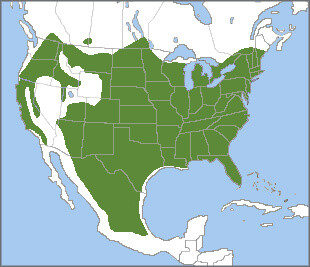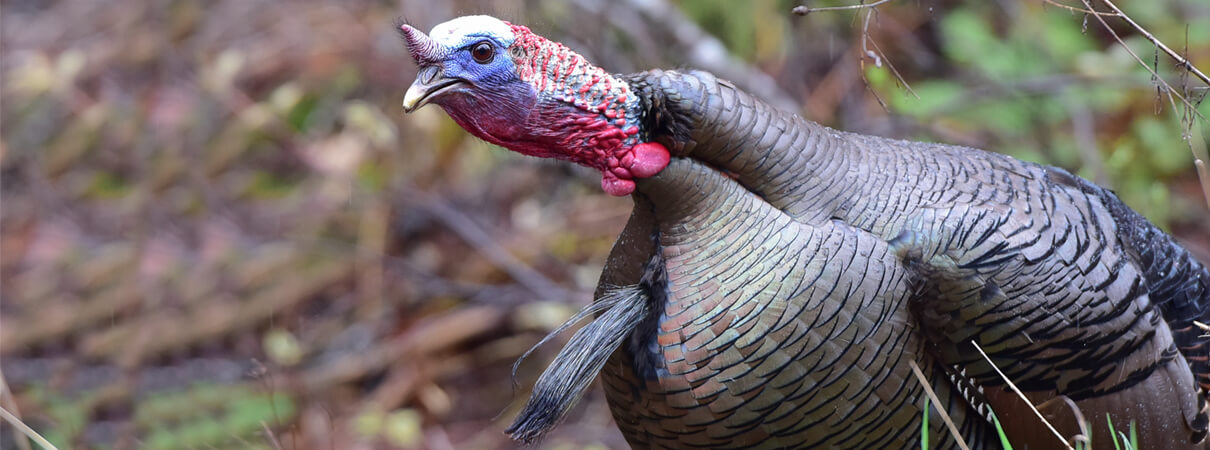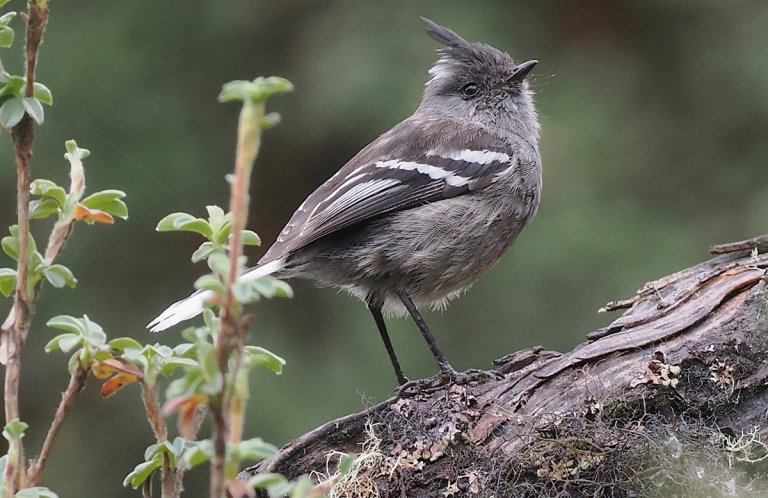
Wild Turkey range map by Birds of North America, https://birdsna.org, maintained by the Cornell Lab of Ornithology
The Wild Turkey, like the Osprey and Bald Eagle, has an inspiring comeback story. Thanks to concerted conservation efforts throughout the 20th century, this native bird has been restored to most of its original haunts.
The Wild Turkey is the largest North American gamebird, weighing up to 20 pounds, with a wingspan of up to five feet. It's colorful, too — decked out in iridescent feathers of bronze, gold, and green, accented by colorful skin ornamentation and spurred legs.
Despite its somewhat unwieldy appearance, the Wild Turkey is a fast runner and strong short-distance flyer, with excellent vision and an intelligent, wary nature that makes it elusive quarry.
Turkey Tales
Contrary to popular myth, Benjamin Franklin never proposed the Wild Turkey as a national symbol, although he praised the species in a letter to his daughter, calling it “a much more respectable bird” than the Bald Eagle, which had already been nominated as the national bird. Franklin considered the Bald Eagle a bird of bad character, due to its habit of stealing other birds' prey.
The Wild Turkey really is named after the nation of Turkey. This unlikely moniker was bestowed by early Europeans, who saw Wild Turkeys and were reminded of another ground-dwelling species they called the "Turkey bird," a guineafowl from Africa. This was likely the Helmeted Guineafowl, a species that had reached Europe in the Middle Ages via trade with Turkey.
Ground-dwelling Group
North America's Wild Turkey has six distinct subspecies, differing mainly in plumage details. The species belongs to a large, diverse group of ground-dwelling birds that includes the Greater Prairie-Chicken, Great Curassow, and Northern Bobwhite. It is one of only two native North American bird species that have been domesticated. (The Muscovy Duck is the other.)
Ancient Mesoamericans were the first to domesticate Wild Turkey, using its meat and eggs as sources of protein and their feathers for decorative purposes. Early European visitors to North America took domesticated Wild Turkeys from northern Mexico back to their home countries. Later, additional domesticated turkeys were sent back across the ocean with returning English settlers in the 17th century.
Springtime Strut
Turkey courtship begins in late March and early April. Males display for prospective mates by strutting back and forth with feathers puffed, wingtips lowered to the ground, and tails fanned. They also vocalize, emitting a series of loud gobbles to lure females from a distance and to discourage competing males. Turkeys make a wide variety of other sounds, including clucks, purrs, and yelps. Listen to a male turkey gobble, plus other turkey sounds, here:
(Audio: Wild Turkey males by Mary Beth Stowe, XC71044. Accessible at www.xeno-canto.org/71044 Wild Turkey hen by Andrew Spencer, XC13619. Accessible at www.xeno-canto.org/13619 Wild Turkey hen with chicks by Paul Driver, XC70532. Accessible at www.xeno-canto.org/70532)
Wild Turkeys are polygynous: One male will mate with multiple females. Once mated, a hen turkey lays her large clutch of 10 to 15 eggs in a shallow depression on the ground, concealed by grasses, vines, or other vegetation. Young turkeys, called poults, are precocial, meaning that they hatch fully feathered, with eyes open, and are able to scramble after adults mere hours after hatching.
Wild Turkeys are omnivorous, foraging in flocks on the ground for a variety of nuts (particularly acorns), seeds, fruits, insects, and small vertebrates. Wild Turkeys introduced to the Hawaiian Islands have even learned to forage for crabs on the beaches!

Tom turkey's snood (on the forehead), wattles (on the neck) and beard (on the chest). Photo by Dave Nelson, Shutterstock
Wattles and Snoods
Male turkeys are called toms or gobblers, while females are known as hens. On his chest, a tom has a tuft of modified, filament-like feathers called a beard, which continues to grow as the bird ages. Mature gobblers can have beards over nine inches long. A small number of hens also have beards.
The male's bare head and neck are decorated with fleshy lobes of skin called wattles, as well as a protuberance on the forehead known as a snood. A tom turkey can change the size and color of these ornamentations by contracting and relaxing small blood vessels in his head and neck.
Male turkeys also sport curved spurs on their lower legs. These bony projections grow up to two inches long and are used to fight for dominance and in self-defense. Older birds have the longest, sharpest spurs.
From Extirpation to Proliferation
Overhunting and habitat loss led to steep declines in Wild Turkey populations during the 19th and early 20th centuries. By the early 1900s, the species was extirpated (gone completely) from many areas, with only about 200,000 birds left. Conservation efforts over the past century, with funds from the Pittman-Robertson Act and multi-state trap-and-transfer programs, led to its dramatic resurgence.
ABC works with the Sustainable Forestry Initiative in the southeastern United States to preserve important habitat needed by the Wild Turkey and many other birds.
The successful comeback of the Wild Turkey serves as an example for recovery efforts needed for other North American bird species, particularly in light of a recently published report detailing the loss of more than a quarter of America's birdlife — nearly 3 billion birds — since 1970. ABC has responded to this news with our 50-50-5 conservation plan, which includes a commitment to save 50 flagship bird species, protect and conserve 50 million acres, and fight five critical threats. You can help us implement this plan, or take other measures to help reverse this distressing decline.
Donate to support ABC's conservation mission!




















































